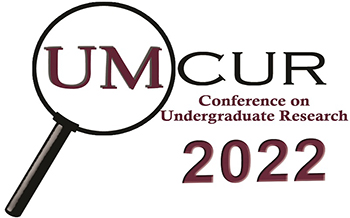Presentation Type
Poster
Faculty Mentor’s Full Name
Orion Berryman
Faculty Mentor’s Department
Chemistry
Abstract / Artist's Statement
Ion transport is critical to cellular function. Cells use molecular channels embedded in cell membranes to transport ions across the cell membrane. The movement of ions regulates pH and ion gradients, forms ATP during aerobic respiration, and mediates action potential in neurons. When these transporters mutate, ions cannot cross membranes, resulting in “channelopathies” — diseases that include cystic fibrosis and neuronal disorders like epilepsy. However, synthetic ion channels can combat these channelopathies by acting as replacement transporters that integrate into the membranes and restore ion permeability.
Unlike natural transporters that use amino acids as building blocks, our research focuses on molecules that use non-covalent interactions to fold and bond anions. Specifically, we utilize hydrogen bonding and halogen bonding interactions to create large molecules called “anion foldamers” which transform into discrete structures around anions. Foldamers are easily manipulated due to their modular synthesis. This allows for substitution of individual pieces within the molecule. If the foldamers can span membranes and adequately bind anions within their helical conformations, this may provide a new mechanism for synthetic anion transport.
This presentation highlights how we used polyethylene glycol chains to increase the solubility of our oligomers in a range of solvents. Adding polar caps to the nonpolar core also makes the foldamer more lipid-like, thus making integration into membranes more feasible. Solution data analyses show how these molecules fold and bind anions in different environments and crystal structures reveal that these foldamers form a helical structure around a guest molecule. Future studies will utilize assays to determine anion transport efficiency and selectivity of the foldamers. If the assays show sufficient anion transport, our molecules could serve as the basis for halogen bond enhanced anion transport in cells.
Category
Physical Sciences
Synthetic anion foldamers utilizing halogen bonding
UC South Ballroom
Ion transport is critical to cellular function. Cells use molecular channels embedded in cell membranes to transport ions across the cell membrane. The movement of ions regulates pH and ion gradients, forms ATP during aerobic respiration, and mediates action potential in neurons. When these transporters mutate, ions cannot cross membranes, resulting in “channelopathies” — diseases that include cystic fibrosis and neuronal disorders like epilepsy. However, synthetic ion channels can combat these channelopathies by acting as replacement transporters that integrate into the membranes and restore ion permeability.
Unlike natural transporters that use amino acids as building blocks, our research focuses on molecules that use non-covalent interactions to fold and bond anions. Specifically, we utilize hydrogen bonding and halogen bonding interactions to create large molecules called “anion foldamers” which transform into discrete structures around anions. Foldamers are easily manipulated due to their modular synthesis. This allows for substitution of individual pieces within the molecule. If the foldamers can span membranes and adequately bind anions within their helical conformations, this may provide a new mechanism for synthetic anion transport.
This presentation highlights how we used polyethylene glycol chains to increase the solubility of our oligomers in a range of solvents. Adding polar caps to the nonpolar core also makes the foldamer more lipid-like, thus making integration into membranes more feasible. Solution data analyses show how these molecules fold and bind anions in different environments and crystal structures reveal that these foldamers form a helical structure around a guest molecule. Future studies will utilize assays to determine anion transport efficiency and selectivity of the foldamers. If the assays show sufficient anion transport, our molecules could serve as the basis for halogen bond enhanced anion transport in cells.
